You Are Coaching Your Reps Wrong. These Unconventional Strategies Will Return $29 Per Each $1 Invested

Each year, US companies spend $20 billion on sales coaching. Scary number, right? On the other hand, every dollar invested in coaching can return as much as $29 in incremental revenue, leading to an overall revenue increase.
That only means one thing – sales coaching is worth every $ and every minute.
If done right!
If not… you can spend as much as 24K per person/year on a productivity improvement program that might not even pay off. That’s how much an average organization pays.
Stay with us and learn about 3 unconventional coaching strategies that promise return both on money and time investment. ⬇️
First, let’s get a few things straight…
But before we get to the actual strategies, there are 3 fundamental things you need to know about coaching your sales team.
Sales Coaching Isn’t a University Course
Do you give your agents 20 page-long documents to study and hope they will become sales superstars? Well, product knowledge is important, but it’s not what makes them sell better. In fact, it’s quite the opposite.
According to Gartner research, B2B sales representatives forget 70% of what they learned within one week and 87% within one month. Without practical role play and practicing real situations, theoretical knowledge is a waste of time.
At CloudTalk, we recently implemented regular role-playing into our sales coaching strategy. The result? Shorter sales cycles and an increase in our win rate to 40% month over month.
You don’t have to believe us. It’s our blog, after all. Of course we would say it works wonders.
But you can trust our sales reps:
“One of the most valuable training experiences I had was a role play session with our CRO. He sat down with me and taught me the power of asking the right questions the right way. For example, how to speak to prospects when discussing sensitive topics. Based on this one coaching session, I created a checklist of things I should never forget to ask or say.”
Dominika S., Account Executive in CloudTalk
Never Forget Your Core 60%
When coaching sales reps, it seems logical to focus on the 20% who are underperformers who don’t bring money. Companies also pay a lot of attention to 20% of overachievers – the top tier reps – who are bringing a lot of money. The remaining 60% falls into a void.
But what if we told you that the real value lies among those 60% of your core (a.k.a. average) performers?
Armand Farrokh, a Founder of 30 Minutes to President’s Club, explains why investing in not the lowest performing reps is like investing in a quality house:
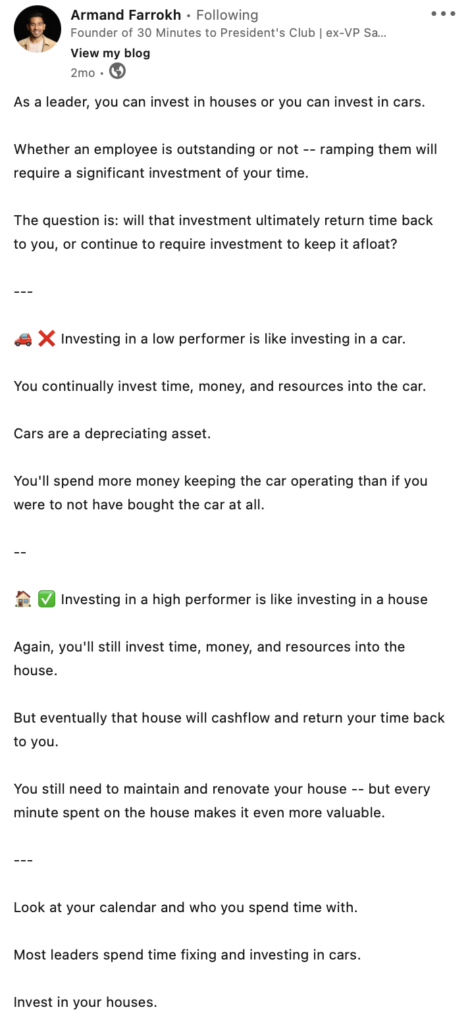
Although you should never give up on your rep without helping them improve first, there’s a possibility that the bottom 20% aren’t suited for the role. If they are underperforming long-term, you may be wasting resources on reps that will never pay it back.
Just as Armand Farrokh said – you’ll spend more money keeping the car operating than if you hadn’t bought the car at all.
On the flip side, your highest performers are already bringing in a lot of profit. Focusing solely on them won’t bring you too much fruit.
Rather turn those with great potential, your core performers, into elite players. Instead of perfecting what’s already (close to) perfect, you’ll get more sales superstars.

To Truly Understand Performance, You Need The Right Tech
In improving performance, technology is your best friend. 90% of salespeople say collaborative technology like CRM software cuts down their close times and allows them to focus on more important things – like working on their sales techniques.
Then, there is calling software (yes, like CloudTalk). They open the door to your reps’ everyday activities.
You can witness their wins and see their struggles. That helps you identify winning behaviors and find areas of improvement.
How?
- You can follow their real-time performance.
- You can get a complex overview of each call with AI-powered tools.
- Or you can also directly jump on the call when a rep struggles.
- You can listen to their conversations and monitor them as they happen.
Talking about recording and listening to phone calls, here’s an interesting piece of advice for you. In the 20Sales podcast, Doug Adamic, a CRO in Brex, shared what to consider when listening to a sales call recording.
“We break calls down into specific steps – how much are reps listening, what kind of discovery questions are they asking, whether they are accessing unique information we otherwise wouldn’t get, and what they do with this information to change the buying criteria and ultimately lead prospects to our solution.”
Doug Adamic
But enough about tech.
Now, let’s take a look at those promised coaching strategies.
Sales Readiness Group’s Proficiency / Motivation Framework – Dive Into Reps’ Psyche
It’s easy to keep things personalized when you have a team of 5 agents. But what if your team grows? Then it becomes very time-consuming to have a personalized coaching plan for each individual.
It may be worth a try, though. Sales reps with only up to 30 minutes of learning time per week receive a win rate of 43%. Extend your coaching sessions to 2 hours, and that number suddenly grows to 56%.
To keep things personalized without identifying reps’ weaknesses individually, try this strategic framework developed by the Sales Readiness Group. Based on a simple survey filled out by each rep, reps are clustered into 5 categories based on two key criteria – proficiency and motivation – the two main factors affecting performance.
You can then pursue a coaching strategy suitable for each category.
Here’s a breakdown:

1. Empowering – high proficiency/high motivation
When we are very good at something and love to do it, it’s easy to lean into these strengths. And yes, we did tell you that training the upper 20% isn’t worthwhile. But that doesn’t mean you should let them stagnate.
Here’s an inspirational story from J. Poland, a senior AE at Tropic and co-founder of 8STR8. He talked about how getting out of focusing on his strengths and instead embracing his weaknesses made him an even better seller:
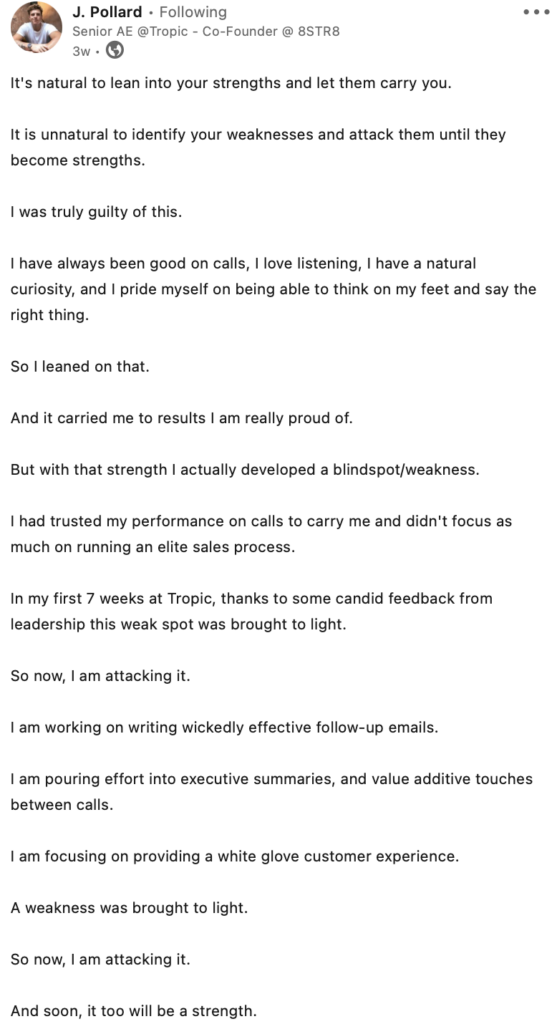
With empowerment, you are basically coaching your reps by not coaching them at all. You simply increase their accountability.
Why? Because one’s own decisions drive motivation and keep it high in the long term. If reps come up with their own plans, they’ll own them.
You need to give them new responsibilities and independence. Show them you trust them.
For example, give your reps an important prospect to handle on their own. Provide the details and let them do their thing. Not only will you give them a bigger challenge, but also free up your own schedule.
Of course, you should also provide them with tools to succeed. For example, on-demand training, sales-ready materials, examples of good demos, and so on.
Sales coaching tip: Giving incentives is also a frequent empowerment strategy. But it may be counterproductive if you aren’t doing it right. The result of offering incentives should be creating new habits, not reinforcing existing ones.
Instead of simply offering $100 to the first rep who makes a sale that day, design the incentive based on actions you wish to improve. Let’s say the reps aren’t selling a service you are trying to emphasize. Reward a person who will come up with the best sales pitch.
2. Training – low proficiency/high motivation
This category often (but not necessarily) applies to newbies whose knowledge is limited, but who are excited about their new role. According to Forbes, 55% of salespeople generally lack basic sales skills.
The best way to help them shine is through training. It is more structured than coaching. Training is done in small groups instead of 1-on-1 sessions. Don’t forget to keep it practical and reinforce reps’ knowledge regularly.
Sales coaching tip: To be more efficient, create pre-recorded training that reps can watch at their own pace. You guide them with a very structured learning framework (different from the on-demand training in the Empowering section).
The most important thing to apply is skill-based training. Do not create a one-size-fits-all program as most companies do. Make sure you tailor your learning path to the role, the experience, and the objectives of your reps.
3. Directing – low skills/low motivation
When it comes to reps who lack both skills and motivation, you need to be as direct as possible. Don’t be harsh. Simply give these reps direct instructions on what, when, and how to do what’s necessary to accomplish their goals.
For example, you can create a skill improvement matrix. This can be a simple Excel sheet with specific requirements, related knowledge sources (articles, training, videos, podcasts…), and of course, a timeline.
We tried it ourselves – maybe not in sales, but it proved to work very well for our Content team. It’s an easy-to-grasp, structured method of learning.
And one more thing we’d like to mention regarding directing – be careful not to fall into micromanagement. If reps are demotivated already, having their boss constantly looking over their shoulder won’t help.
Our pro advice: Don’t give up on underperforming reps without a fight. Not only can they grow into great salespeople, but letting them go hits your wallet and schedule hard. On average, onboarding a new agent costs over $9,500 and lasts almost 40 days.
4. Performance counseling – high skills/low motivation
You can have a group of excellent sales people capable of closing any deal, but they won’t do any good if they… well, don’t want to.
Training, coaching, and role-playing isn’t as crucial for this group. What you should focus on is counseling – evaluating and discussing their performance and its impact on the team. But be careful to do this right. Never blame them. Motivate them.
For example, leveling plans, sales awards, open feedback culture, and company-wide recognitions are good ways to increase motivation.
5. Coaching – Average skills/average motivation
Here they are again – your core 60%. These reps have a decent skill set you can fine-tune and a promising level of motivation. A great baseline for coaching.
By investing time into them, you are slowly moving them to the highest tier of your top performers.
But by investing your time, we mean really investing your time.
As Christian Krause, sales pro and a finder of SaaS Sales academy, explains, one quick product training won’t cut it:
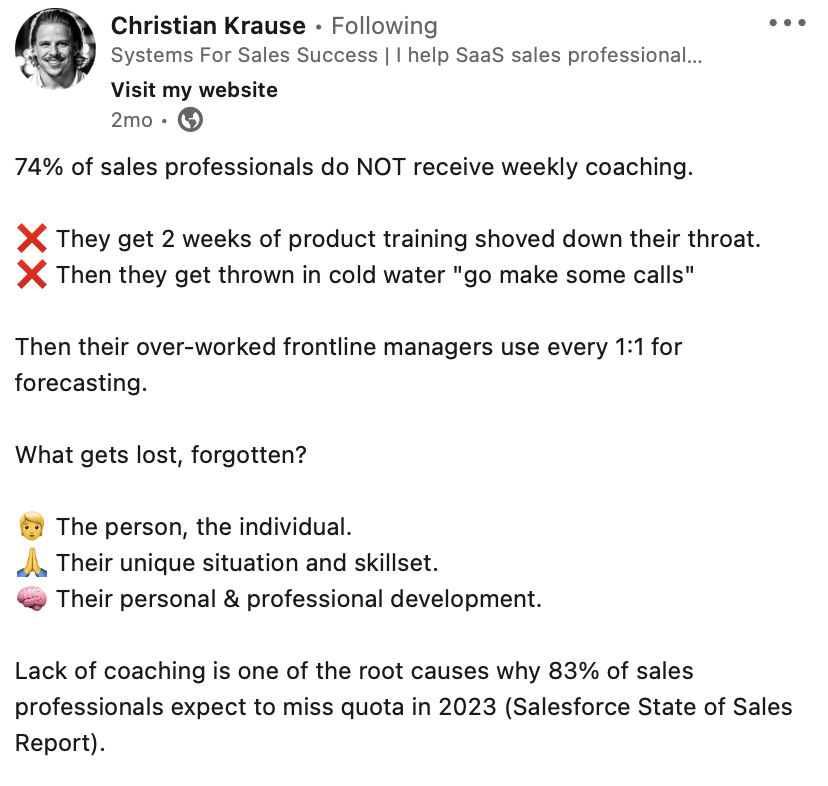
Of course, equally important is what you are teaching your reps.
Here’s what we focus on in our coaching program:
With SDRs:
- Building rapport
- Creating engagement and excitement for the demo
- Identifying problem areas
- Enforcing the BANT prospect evaluation framework
- Articulating a powerful value proposition
With AEs:
- Running an in-depth discovery
- Identifying the pain
- Running a value-based demo (not focusing on features only)
DiCristo-Schmitt’s 3-month Behavioral-Shifting Framework For Adjusting Mindset
Only 60% of sales reps meet their quotas. In order to continuously keep them close to 100%, DiCristo-Schmitt’s framework maps reps’ common behavioral patterns throughout 3 months and sets how to work with reps in different stages of the shifting mindset.
Note that while this framework refers to reps with month to month quotas, you can do the same quarter to quarter in case they follow quarterly or annual quotas.
STEP ONE: Understand The Mindset
Month 1: If reps are missing on quota for less than 30 days, reps’ motivation probably didn’t suffer significant damage. It’s quite normal –we all have bad days.
Month 2: At this point, reps may start to doubt themselves – are they right for this career? They may begin to consider leaving your company as their motivation drops.
Month 3: Reps are heavily demotivated and are probably already looking for a new, more suitable career. In this stage, it’s very difficult to restore motivation.
STEP TWO: Create The Right Development Strategy
A performance improvement plan should be triggered whenever sales reps don’t hit 100% of their monthly quota.
Month 1: Building a Rep-Driven Success Plan
At this stage, you need to build a 30-day-long plan that sales reps implement by themselves. It should focus on 3 things – strengths, scope of work, and specific challenges.
Build a precise sequence of steps with deadlines. According to research, teams with clear action plans may raise their win rates by 7% (from 44% to 51%). Reps have to clearly understand where they need to get, as well as how and when they should get there to achieve their goals.
Our pro advice: Each month, we choose one small thing that the rep should make an effort to improve – for example, an opening sentence. Then, we give reps space throughout the month to practice and implement it. It’s also called a “small experiments” strategy, and it makes for more in-depth, less overwhelming learning.
Month 2: Collaborative Planning With The Sales Director
This is where you start to play an active role in the process. When quotas are missed 2 months in a row, leadership should revisit the plan and identify what may not work well.
From here on, leadership is also an active part of the process. You should share your expertise, attend calls with clients (or listen to those calls in real-time with a pro calling software…), look out for mistakes, and incorporate role plays based on specific findings.
“I remember that one deal I was about to lose. To prevent it, our CRO followed me through the entire process. He led me step by step through the communication with the prospect and provided feedback on every email I sent. Guess what – we ended up closing that deal.”
Dominika S., Account Executive in CloudTalk
And one more thing before we move on: at this stage, we recommend weekly meetings to gradually review reps’ KPIs.
Month 3: Performance Improvement Plan
If the rep still struggles after 3 months, it’s time for a Performance Improvement Plan (PIP) highlighting specific areas of improvement, targets, and deadlines.
The plan should have clear areas for improvement but also be realistic and achievable for that specific rep. It’s important to set measurable targets and regularly review them.
Rain Group’s 5-step Coaching Template, For Real Maximalists
When researching for this blog, we found this detailed coaching plan sequence and we were so stunned by the level of detail that we simply had to list it here.
Here’s their step-by-step template.
Set what a rep should do differently…
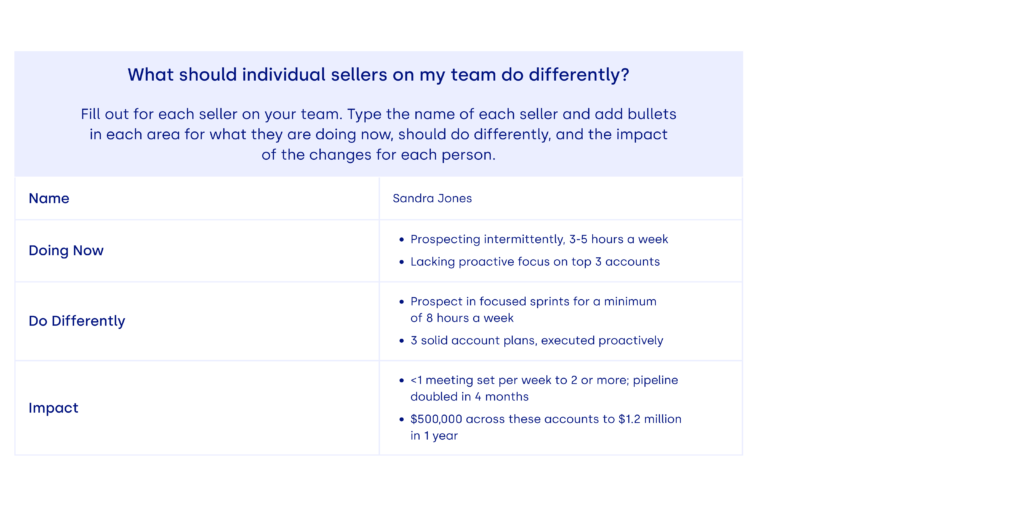
…and what should the team do differently
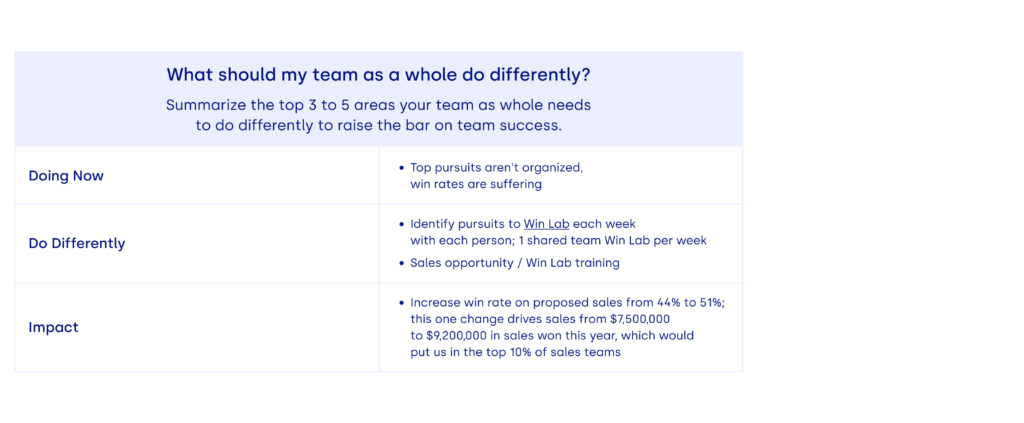
Determine meeting rhythm
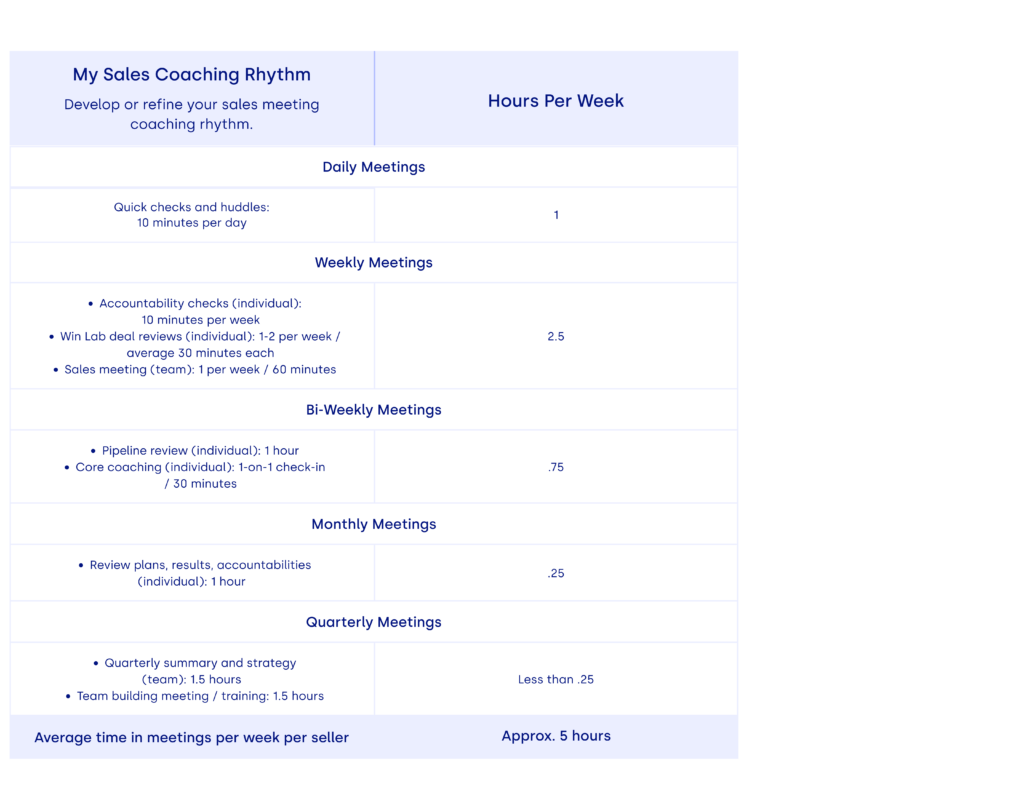
Put together a rep’s development plan
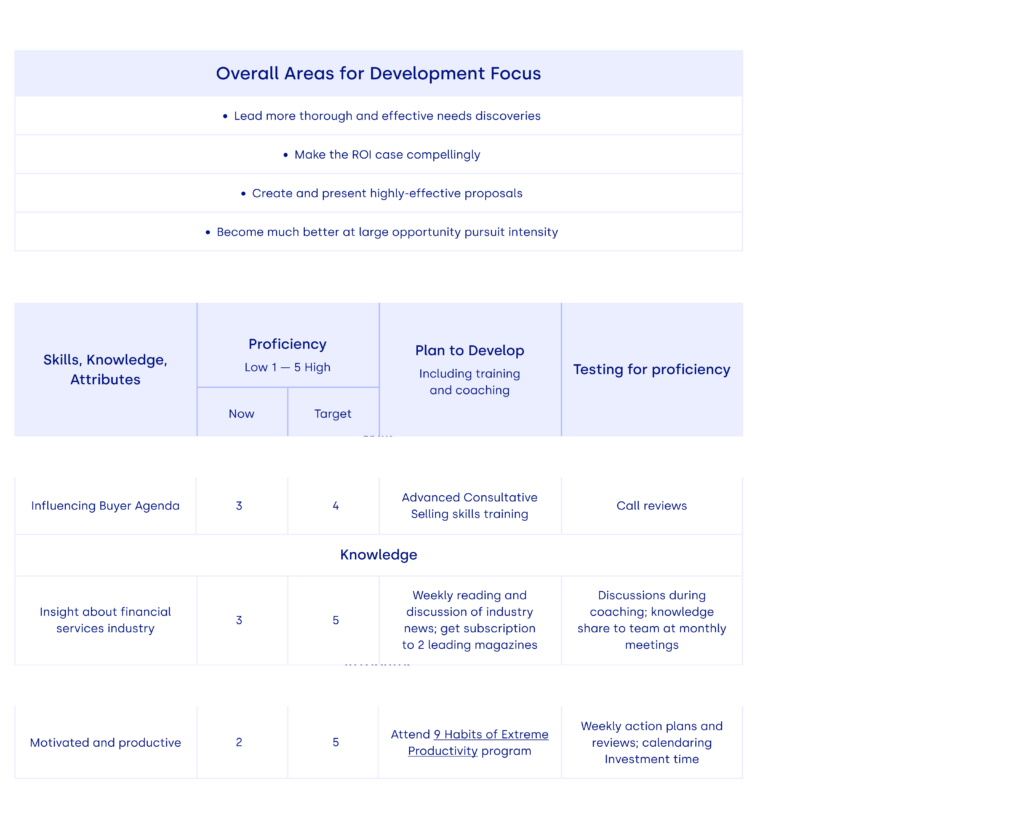
Determine priorities and Actions
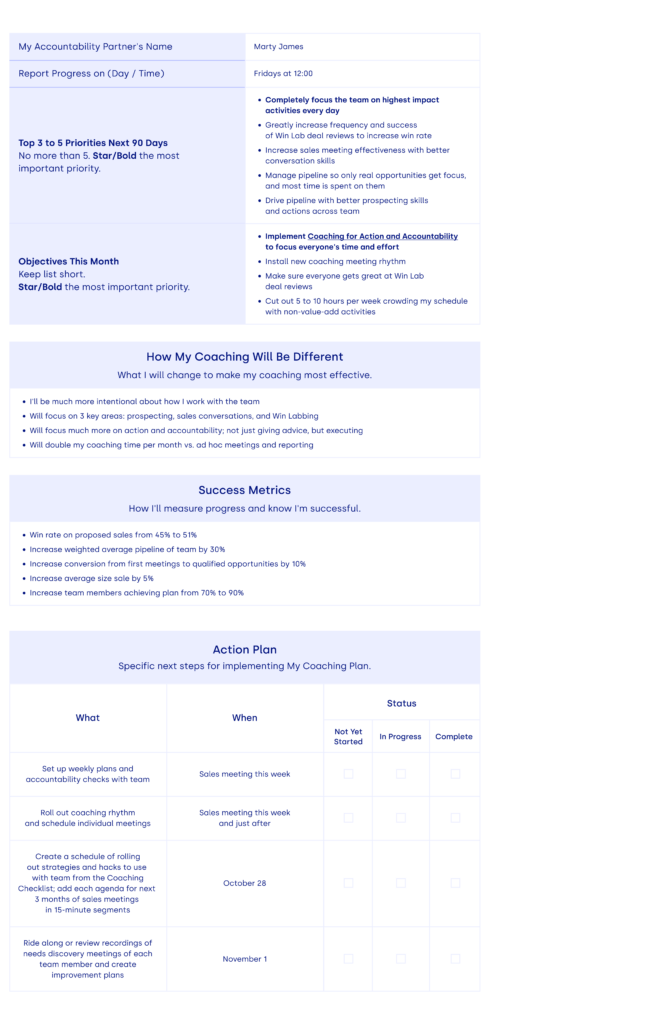
Like the framework? Download the full PDF version.
Besides, we also loved these templates:
HubSpot’s specialized templates focused exclusively on Skill Development and Sales Performance Improvement: https://www.hubspot.com/resources/template/sales-coaching
These templates were created by sales experts at G2, Outreach.io, Dealpath, and more, to help other sales experts: https://ambition.com/resources/templates/sales-coaching-templates/
…And the best comes at last ⬇️
CloudTalk’s Discovery Cards Checklist, For TRULY Thorough Evaluation
We play a fair game with our sales reps when evaluating their performance.
Our sales leaders created a comprehensive set of criteria each rep should equally fulfill. It’s personalized, in-depth, and provides them with a detailed checklist of everything they need to keep an eye on.
Simply put, the discovery cards give us a great way to stay on track with how reps are doing and identify where they need to improve.
Here’s the checklist:
Discovery cards for Account Executives
CATEGORY → Call presence & credibility
AE’s energy is positive and makes the prospect want to engage
AE establishes a high level of credibility and likability (Introduces himself/herself professionally and originally)
AE connects with prospects on a professional and personal level (prior research is leveraged to find common areas of interest)
AE uses positive language throughout the entire call
CATEGORY → Deal control
AE lays out a clear Upfront contract at the beginning of the call
AE respects the recommended structure for the call
AE secures relevant next steps
AE constantly probes the prospect to ensure alignment
AE properly mapped out the competitive environment, the power map & the decision-making process
AE understands the high-level timeline
AE asks tough questions to understand how he/she stacks up against expectations
CATEGORY → Problem-centric discovery
AE includes a slide summarizing the key information brought up in the BDR qualification call (Context, Challenges) as well as a POV on how CloudTalk can help.
AEs come to the call with information on the company’s business that demonstrates its strong understanding
AE asked questions surfacing the key challenges, the root causes of these challenges and the impact these challenges have at the company & personal level
CATEGORY → Value-based product tour
AE follows a clear demo workflow in line with what the prospect wants to see
AE shows the most valuable features to the prospect within the first 5 minutes of the demo
AE ties back every feature shown to the challenges identified in Discovery
AE clearly indicates the 1 or 2 killer features that will drive the most value for the prospect
AE demo environment is filled with data and is 100% ready for demonstration
AE summarizes key demo highlights at the end of the call
Discovery cards for Inbound SDRs
CATEGORY → Open & Introduction
SDR personalizes the opening based on the prospect’s specific context, showing that they have a genuine interest in their business.
SDR demonstrates some confidence with a tone of voice that is positive, engaging, and professional.
SDR focuses on a value statement that highlights a specific benefit or outcome CloudTalk can deliver. It should resonate with some of the prospect’s pain points.
CATEGORY → Engagement & Rapport
SDR demonstrates active listening skills by showing genuine interest in what they are saying, using verbal cues to indicate their attentiveness, and tailoring their conversation based on the prospect’s answers.
SDR identifies the prospect’s goals and aligns the value proposition with their aspirations.
SDR acts as a trusted advisor by sharing relevant insights or industry-specific knowledge that can benefit the prospect.
SDR uses open-ended questions that encourage the prospect to share more information and insights
CATEGORY → Call Flow
SDR demonstrates full control of the call by following a standard structure while remaining flexible based on the conversation with the prospect.
SDR sets expectations at the very beginning of the call by sharing a very brief agenda.
SDR transitions effectively into asking qualifying questions (needs, pain points, and challenges) while keeping a value-based conversation.
SDR clearly defines the next steps and a call to action.
CATEGORY → Qualification
SDR effectively performs AN
SDR is able to tie all the qualification criteria to the prospect’s goals and pains.
SDR understands if the prospect is evaluating other solutions and is able to present concisely how CloudTalk compares to the competition and highlight its unique advantages.
SDR provides relevant information, facts, or data that directly address the prospect’s objection.
CATEGORY → Objection handling
SDR shows empathy towards the prospect’s objection and acknowledges their concerns.
SDR seeks clarification by asking open-ended questions related to the objection.
SDR presents potential solutions or alternatives that address the prospect’s objection.
SDR uses social proof of businesses that have experienced success by using CloudTalk
SDR seeks agreement and asks for the prospect’s input on the proposed solutions or suggestions.
CATEGORY → Outcome
SDR booked a discovery call with AE or a second call with SDR
All qualification requirements have been captured
60% Of Sales Reps Leave Bad Coaches Behind
Let’s close up with a little sports analogy. It may seem off-topic, but it isn’t.
Many times, we heard people comparing sales reps to sportsmen. Coaching salespeople isn’t that different from coaching world-class athletes.
There’s one big difference, though. Sales reps are usually much more disconnected from their coaches, lacking trust. As much as 60% of sales reps say they’re more likely to leave their jobs if their manager is a poor coach.
Just as Patrick Carter, a Sales Leader at Optimum.com, explains in his post:
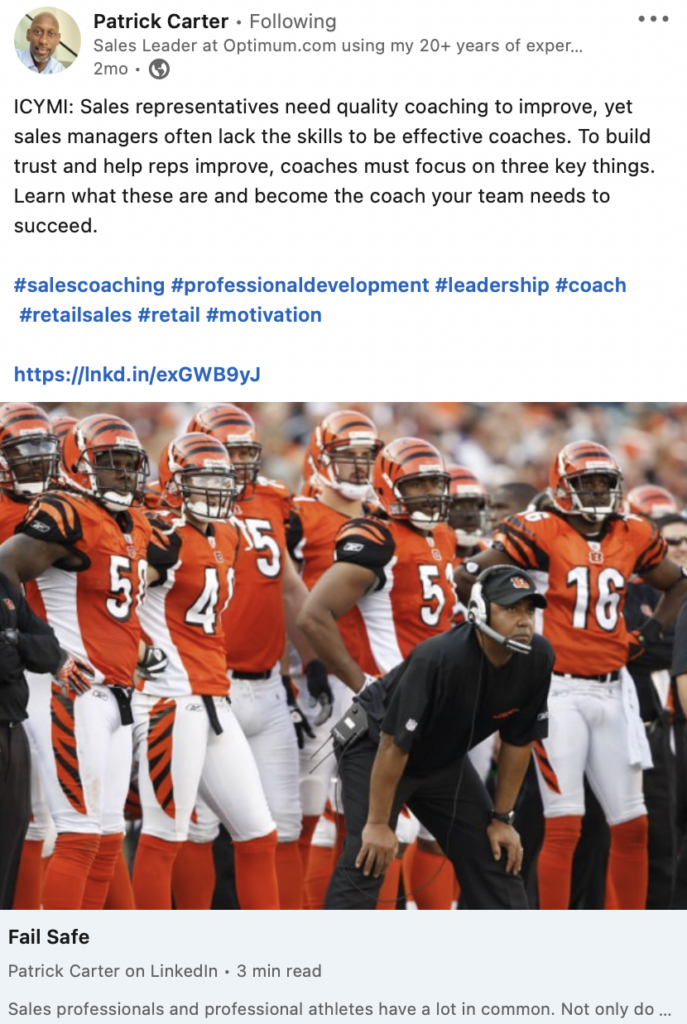
Remember, success is about reciprocity. In order to have well-trained sales people, you must be a well-trained coach.
So play fair with your people. Create a strong coaching strategy, show that you care about their growth, (of course, get the right technology…), and become the best in the field.
We are glad you started with our blog.
Rain Group template source: https://www.rainsalestraining.com/blog/building-your-sales-coaching-plan




















